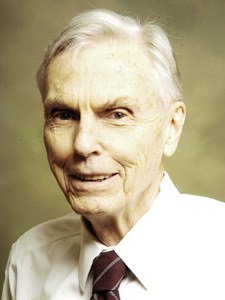International conference honors prize-winning Minneapolis-born mathematician

Media Note: To schedule an interview with John T. Tate, Jr., between Monday, Jan. 3 and Saturday, Jan. 8, contact Rhonda Zurn at rzurn@umn.edu.
Contacts:
Rhonda Zurn, College of Science and Engineering, rzurn@umn.edu, (612) 626-7959
Preston Smith, University News Service, smith@umn.edu, (612) 625-0552
$1 million Abel Prize is equivalent to Nobel Prize for mathematics researchers
MINNEAPOLIS / ST. PAUL (12/22/2010) — Minneapolis-born mathematician and 2010 Abel Prize winner John Torrence Tate, Jr., will return to his hometown to be honored at the First Abel Conference at the University of Minnesota Jan. 3-5. The University’s Institute for Mathematics and its Applications is hosting the conference in collaboration with the Norwegian Academy of Science and Letters with support from IBM Research.
Tate was awarded the $1 million Abel Prize, an international prize for outstanding scientific work in the field of mathematics first awarded in 2003. Tate received the award for his vast and lasting impact on the theory of numbers at a ceremony in Norway last May. He will receive special recognition from the University of Minnesota during the opening session of the First Abel Conference at 11 a.m., Monday, Jan. 3 in Room 3-180 of the University of Minnesota’s Keller Hall, 200 Union St. S.E., Minneapolis.
About John T. Tate, Jr.
Tate is the son of world-renown physicist and former University of Minnesota physics professor John T. Tate, Sr. The University of Minnesota’s Tate Laboratory of Physics Building is named after Tate, Sr.
Tate, Jr. was born in Minneapolis in 1925 and grew up in Minneapolis while his father was a professor at the University of Minnesota. He graduated from St. Paul Academy in 1942. Tate received his bachelor’s degree from Harvard in 1946 and his Ph.D. from Princeton in 1950.
After receiving his Ph.D., he served as a research assistant and instructor at Princeton (1950–53) and a visiting professor at Columbia University (1953–54). In 1954, Tate returned to his alma mater, Harvard University, where he served as a professor for the next 36 years. In 1990, he accepted his last academic position as professor and Sid W. Richardson Chair in Mathematics at the University of Texas at Austin. He recently retired from this position.
Over the course of the last six decades, Tate has left his mark on modern mathematics. He has made fundamental contributions in algebraic number theory and in related areas of algebraic geometry. Because of his work, numerous mathematical concepts are named after him. In mathematics literature, there are references to the Tate module, Tate curve, Tate cycle, Hodge-Tate decompositions, Tate cohomology, Serre-Tate parameter, Lubin-Tate group, Tate trace, Shafarevich-Tate group, Néron-Tate height, and more.
Tate has received several awards for his work including the Cole Prize and Steele Prize for Lifetime Achievement from the American Mathematical Society, the Wolf Prize in Mathematics, a Sloan Foundation Fellowship and a Guggenheim Fellowship. John Tate was elected to the U.S. National Academy of Sciences in 1969. He was named a foreign member of the French Academy of Sciences in 1992 and an honorary member of the London Mathematical Society in 1999.
For more information
For more information on the Abel Conference at the University of Minnesota, including a schedule of workshops, visit http://z.umn.edu/imaabelconference. For more information about the Abel Prize and to see a video interview with Tate about his early interests in math, visit http://www.abelprisen.no/en.
